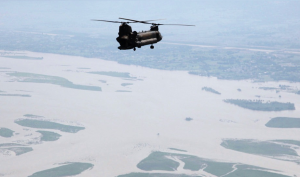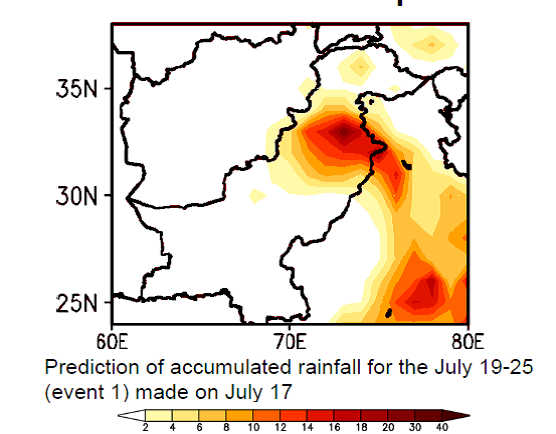Pakistan Flood 2014- Lesson Identified Never Learned
Contributed by Bapon Shm Fakhruddin
 I wrote similar article right after 2010 floods. I had a chance to work in Pakistan to conduct some climate risk management assessment and training program for the Government officials on climate risk management during 2009-2010. Based on my assessment, major recommendation was to strengthening flood forecasting and warning system with longer lead time and community level awareness to interpret the flood forecasts for decision making!
I wrote similar article right after 2010 floods. I had a chance to work in Pakistan to conduct some climate risk management assessment and training program for the Government officials on climate risk management during 2009-2010. Based on my assessment, major recommendation was to strengthening flood forecasting and warning system with longer lead time and community level awareness to interpret the flood forecasts for decision making!
There has been some steps taken by Pakistan Met office (PMD) to strengthen the system but comparing to donor’s supports that perhaps nothings much has been done. Donor supports and NGOs are flooded with resources in Pakistan even though not much focused on flood early warning system! The BBC quoted “Pakistan has not experienced floods as devastating since 2010 – officials say 254 people have died in the past few days”. Though 2010 not so far, I wish they could write something more what lessons were learned and how much they progress so far done to protect 2014 flood!
Advances in meteorological, hydrological and engineering sciences are fast generating a range of new methodologies for forecasting weather and flood events, including ensemble prediction systems (EPS) and new hydrological or hydrodynamic models. However, many of these advances prediction system have not yet been incorporated into operational forecast systems and consequently, operational forecasts have not been integrated into decision making processes in order to reduce disaster risks. In a real world, it has been noticed that not all people noticed warning or able to understand the meaning of probabilistic forecasts and consider themselves at risk. On the consequence, no appropriate actions were taken to reduce damage.
PMD is in charge for issuing flood forecasts and warnings to the nation to help in saving lives and to reduce flood damages. For this purpose, PMD maintains a specialized Flood Forecasting Division (FFD) at Lahore. PMD issues pertinent information on rivers’ condition to local, provincial, and federal decision-makers and to general public.
However, a flood forecast is only of value if it induces a response from the residents in the threatened area that lead to effective actions. Urban flood, Flash flood watches and warning, river and flood forecasts and warning, and water supply forecast and water management at major dams is the major hydrological services provided by PMD.
PMD is able to provide accurate forecasts 24 hrs before, but perhaps 24 hrs too little time to take appropriate actions for property damage but sufficient to save lives (Figure below represent the forecasts of PMD and its accuracy for the forecasts of 3rd September).
Figure 1: Forecasts accuracy for 2014 flood forecasts by PMD
Based on research, it has been proven that the lead time for flood forecasting for Indus Basin could increase 5-7 days with high persistent using ECMWF of other high resolution ensembles precipitation forecasts.
In 2010 ECMWF 1-15 rainfall predicted more than 20 cm during those days (Figure 2). The rainfall forecast was able to capture the 27-29 July events accurately. Figure 3 shows the 15-day forecasts of precipitation in north Pakistan for 27-29 July events (dashed). Multiple forecasts using ECMWF 51 set of ensembles were made to determine probabilities shown in figure 3.
Figure 2: 15-day probabilistic rainfall forecasts (Webster et al., 2011)
(Webster et al., 2011)
The media has reported, in Punjab Province, Pakistan, that 156 deaths have been attributed to heavy rains and floods and 75 people were dead in Pakistani-administered parts of Kashmir and the northern territory of Gilgit-Baltistan, said Zaheer Abbas, an official with the National Disaster Management Authority.
At least 2,100 villages have been badly affected by the flooding. Thousands of villagers in central parts of Punjab are depending on boats and rescue operations to save their lives and livestock. The floodwaters were moving downstream and were expected to reach the southern part of Sindh Province and the southwestern part of Baluchistan Province by the end of the week, officials said.
Figure 3: The probabilities of flood in 1-15 days forecasts (Webster et al., 2011)
This clearly states the lack of communication to receive the warning to the affected people, interpret or internalize the information for decision making and response. Early warning systems alone do not prevent hazards turning into disasters. Early action is essential in order to mitigate potential damage (World Disaster Report, 2009). Early warning and early action together can save thousands of lives and livelihoods; reduce vulnerability and strengthen resilience.
Nevertheless, without lead time to react an early warning is almost ineffective. For taking a good decision, the capacity of generation of long lead flood forecasts with an acceptable degree is essential.
A breakdown in any one of these elements of early warning can cause warning messages to fail to reach and motivate their intended recipients. It’s clear that early warning is not helpful unless its reach to the people who need to act. To respond to the early warning, the information need to be understood and internalized by the people. Thus, an interpretation and translation of the science information is essential.
People do not immediately respond to early warnings because people worldwide first “search” for additional information to “confirm” that they are really at risk. This searching happens despite the technology used to give warnings. Searching is a social phenomenon. It involves talking things over with others and seeking to hear the same warning multiple times from different sources. Warned people turn to friends, relatives, and strangers to determine if they agree that risk is present and if protective actions are warranted. This process, constructing new perceptions of risk out of existing perceptions of safety, adds time before protective actions are taken- it is fundamental to all human beings worldwide, and it is difficult to change.
Early public warnings work best when they are under mandate from a government that is trusted as they can facilitate the process and speed it along. Ignoring these basic human warning elements may continue to cost lives. A decision support system incorporating all these users’ need could enables peoples to visualize the possible scenarios with probabilities of risk to reduce their vulnerabilities.
Further Reading
- Babel, M.S., Fakhruddin, S.H.M., and A. Kawasaki. 2012. A Decision Support Framework for Flood Risk Assessment: An Application to the Brahmaputra River in Bangladesh. Floods: From Risk to Opportunity. IAHS Publication no. 357-2013.
- Cloke, HL, & Pappenberger, Florian. (2009). Ensemble flood forecasting: a review. Journal of Hydrology, 375(3), 613-626.
- Drobota, S. and Parker, JD. 2007.Advances and challenges in flash flood warnings. Environmental Hazards 7:173–178
- Parker DJ, Priest SJ and Tapsell SM. 2009. Understanding and enhancing the public’s behavioural response to flood warning information. Meteorol Appl 2009(16):103–114
- Molinari, D and Handmer, J. 2011. A behavioural model for quantifying flood warning effectiveness. Journal of Flood Risk Management, vol. 4(1), 23-32.
- Fakhruddin. S.H.M (2014). Applications of Medium Range Probabilistic Flood Forecast for Societal Benefits – Lessons Learned from Bangladesh. Reducing Disaster: Early Warning Systems For Climate Change. Singh, Ashbindu, Zommers, Zinta (Eds.) Springer.
- Fakhruddin, S.H.M. (2013) Using science for disaster risk reduction: report of the ISDR scientific and technical advisory group, 2013 . [available here]
- Shrestha K.Y., P.J. Webster, and V.E. Toma, 2014: An Atmospheric-Hydrologic Forecasting Scheme for the Indus River Basin, Journal of Hydrometeorology (in press). See here.
- Rassmussen K., A. Hill, V. Toma, M. Zuluaga, PJ Webster and R. Houze. Three consecutive years of anomalous flooding in Pakistan. Q. J. Roy. Met Soc, under review.
- Webster P. J., V. E. Toma and H. M. Kim 2011: Were the 2010 Pakistan Floods predictable? Geophys. Res. Lettrs.,38, L04806, doi: 10.1029/2010GL046346.



March 12, 2015 at 02:24
Here is an up-to-date list of references. PDFs can be found at my website: http://webster.eas.gatech.edu/papers.html
Rassmussen K., A. Hill, V. Toma, M. Zuluaga, PJ Webster and R. Houze. Three consecutive years of anomalous flooding in Pakistan. Q. J. Roy. Met Soc. . doi: 10.1002/qj.2433
Shrestha, K.Y., P.J. Webster, and V.E. Toma, 2014: An Atmospheric-Hydrologic Forecasting Scheme for the Indus River Basin, Journal of Hydrometeorology (Available at: http://journals.ametsoc.org/doi/abs/10.1175/JHM-D-13-051.1